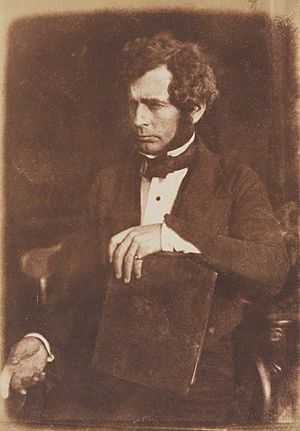George Buist (journalist) facts for kids
George Buist (1805–1860) was a Scottish journalist and scientist. He was famous for editing The Bombay Times. This newspaper later became The Times of India, a very important newspaper in India. People called him "India's foremost man of letters" because he was so good at writing and learning.
Contents
Early Life and Education
George Buist was born in Tannadice, Scotland, on November 22, 1805. His father was Rev. John Buist. George's uncle, also named George Buist, was a leader in the Church of Scotland.
Young George studied at several universities. These included St. Salvator's College, St. Andrews, St. Mary's College, and Edinburgh University. In 1826, he became a licensed preacher. He also gave talks on natural philosophy, which is an old name for science, in 1832.
A Career in Journalism
In 1832, George Buist started his career as a journalist. He became the editor of the Dundee Courier newspaper. He later left to start his own newspapers, the Dundee Guardian and the Scottish Agricultural Magazine.
In 1839, Buist moved to India. He became the editor of the Bombay Times. This newspaper had just started a year before. When he took over, it was published twice a week. By 1850, under his leadership, it became a daily newspaper.
Leading the Bombay Times
Buist worked at the Bombay Times for 20 years. He used the newspaper to share his opinions. For example, he argued against revenge after the Afghan uprising of 1842.
In 1845, he visited the United Kingdom for a few months. During this time, he became a member of the Royal Society. This is a very important group for scientists. He also joined six other learned societies.
Buist returned to the Bombay Times in 1846. He continued as editor until 1856, when he went on leave again. Robert Knight took over as acting editor.
Leaving the Bombay Times
When Buist came back, some shareholders wanted him to change the newspaper's views. A Parsi shareholder, Fardoonji Naoroji, wanted him to be less supportive of the government. This was especially true after the Indian Rebellion of 1857.
However, Buist refused to change his editorial policy. He wanted to keep his independence as an editor. After a meeting of the shareholders, he was replaced by Robert Knight.
Later Years and Interests
After leaving the Bombay Times, Buist continued his work. From 1858, he ran another newspaper called the Bombay Standard. This paper later joined with The Bombay Times.
In 1859, Buist stopped working in journalism. He took a government job in Allahabad, India. He sadly died at sea on October 1, 1860, while traveling to Calcutta.
Scientific and Community Work
George Buist had many interests beyond journalism. He became an unpaid inspector for observatories in Bombay. Observatories are places where scientists study stars and weather.
During his trip to England in 1845, he got special money from the government. This money was for improving farming tools in India. It was also for setting up 12 observatories across India. These observatories would study weather and ocean tides. He also helped create a collection of rocks and minerals for the museum at Elphinstone College in Bombay.
In 1846, Buist was given the honorary job of sheriff of Bombay. In 1847, he helped plan and later founded the Bombay Reformatory School of Industry. This school helped educate and reform Indian children. He was the superintendent of the school.
Published Works
George Buist was a talented writer and scientist. In 1837, he won an award for his paper on the geology of Perthshire in Scotland. Geology is the study of Earth's rocks and soil.
He also wrote many scientific papers for the Journal of the Bombay branch of the Asiatic Society. Before moving to India, he wrote articles about the geography and geology of Perthshire and Fife in Scotland.
Buist created the Bombay Observatory Report for 1844. This report included records from 170,000 observations. He also put together an Index to Books and Papers on the Physical Geography, Antiquities, and Statistics of India in 1852.
Other books and works by George Buist include:
- Geology of Bombay (published in 1863)
- Annals of India for the Year 1848 (published in 1849)
- Manual of Physical Research Adapted for India (published in 1852)
- Floods in India of 1849 (published in 1850)


